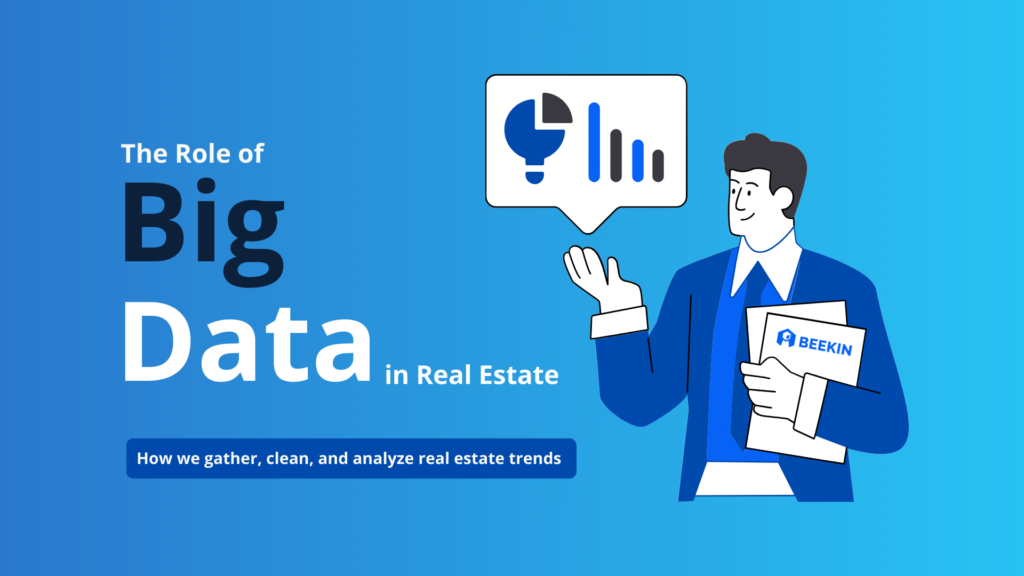
Big data is revolutionizing industries across the globe, and real estate is no exception. The explosion of digitalization, particularly in multifamily revenue management, has made a wealth of data readily available, waiting to be harnessed for a more efficient and insightful process in property investment and management.
As we dive deep into this topic, we’ll discuss the pivotal role of big data in the real estate industry and revenue management, the cutting-edge methods Beekin uses to source, clean, and analyze real estate data, and the inherent challenges and opportunities found in using big data for real estate predictions and multifamily revenue management.
So, Why is Big Data So Important for Effective Real Estate Revenue Management?
Getting a handle on big data is the key to unlocking opportunities in the real estate market. It amplifies the scope beyond basic property details and location data to encompass a more holistic, informed picture of the investing landscape. With it, we can forecast market trends, property hotspots, and even individual property valuation with an unprecedented level of accuracy.
- Finding patterns: Big data allows us to detect patterns and trends hidden in the vast sea of information.
- Identifying opportunities: Accurate, real-time data paves the way for spotting investment opportunities before they become apparent to everyone else.
- Improving decision-making: Data-driven insights lead to more informed, less risky decisions in the real estate industry.
Let’s take a closer look at how Beekin, an AI-powered real estate data analytics platform, pioneers the utilization of big data in the real estate landscape to drastically improve single-family and multifamily revenue management.

Sourcing The Data
In the technologically advanced era we are living in, Beekin redefines the application of big data in the realm of real estate. But the question that might pop in your head is: how do they gather, clean, and scrutinize real estate statistics?
First off, Beekin collects real estate data from a myriad of reliable sources such as governmental databases, multiple listing services (MLS), real estate brokerage firms, and property websites. This wide base of sources ensures a comprehensive scope of data, covering all necessary aspects of the real estate industry.
Cleaning The Data
Next, Beekin applies an array of sophisticated tools and mechanisms to ‘clean’ the data. This phase involves eliminating any inconsistencies, redundancies, and inaccuracies in data. It’s an essential step that ensures that the data enqueued for analysis is accurate, reliable, and ultimately, beneficial.
The cleaned data is then subjected to a rigorous analysis using advanced Machine Learning (ML) algorithms and Artificial Intelligence (AI) tools. This analysis breaks down the massive data into comprehensible patterns and trends that can be used to accurately predict the future dynamism of the real estate market. Hence, transforming raw data into insightful narratives and actionable strategies.
Analyzing The Trends
Beekin have developed intelligent algorithms that are designed to perform complex calculations almost instantly, rapidly processing and interpreting data points. Beekin’s AI models are built to learn from patterns and trends. By finding relationships between different types of data, these models develop an understanding of the real estate market’s dynamics.
For example, they might correlate property value with parameters like…
- Location
- Square footage
- Amenities
- Neighborhood crime rates
- Schools ratings
- Similar properties and many more.
Big data in the real estate world is vast and continually expanding – from building specifications and historical transaction data, to demographic changes and macroeconomic indicators. Beekin’s AI models are designed to handle this data surge effectively, making sense of the multitudes of information available.
Algorithms discern the subtle patterns and nuances often missed by human analysis. They are capable of predicting property market trends or potential investment hotspots, offering valuable insights for sell-side brokers, buy-side investors, and multifamily property owners alike.
Not all data is created equal. In real estate, the accuracy of data is paramount. Beekin’s algorithms sift through vast datasets, separating the wheat from the chaff, ensuring only credible, reliable data is included in the model.

How is The Data Used to Improve Revenue Management?
After sourcing, cleaning, and analyzing all that data, how can it be effectively leveraged to enhance revenue management?
Our AI-driven revenue management solutions can enable functions like:
- Automated daily pricing calibrated to market conditions
- Granular forecasting models down to the unit type and floor plan
- Revenue management analytics like price elasticity and opportunity cost
- Demand-based “what if” scenarios to optimize yield
- Red flag reporting of unexpected performance changes
- Real-time monitoring of review sites and online reputation
- Custom benchmarking against the competition set
- Automated personalized outreach campaigns to prospects
- Predictive analytics to anticipate move outs and renewals
Platforms like LeaseMax use machine learning and AI to continuously refine rental rate recommendations and forecasting models per asset and market. This level of precision isn’t possible with basic reporting.
In a personalized demo, our team will assess your current data environment, strategic goals, and pain points. We’ll then map out ways LeaseMax can help overcome challenges to start driving results optimizing your assets.
Conclusion
Big data in real estate avails businesses with insights that can drastically increase efficiency, minimize financial risk, enhance rental or sales strategies, and eventually, lead to more satisfied clients. Most importantly, it replaces the traditional hunches and spreadsheets with a more sophisticated and efficient data-driven approach.
Get in touch with Beekin today to learn more about how we can help improve your revenue management.